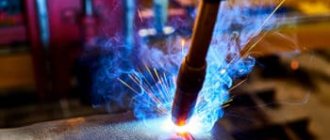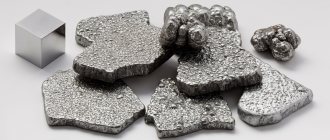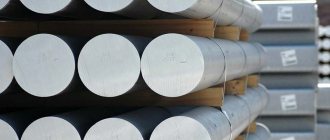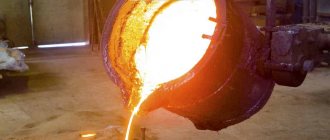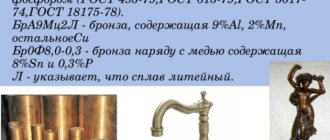| aluminum | |
| Atomic number | 13 |
| Appearance of a simple substance | soft light metal silver-white color |
| Properties of the atom | |
| Atomic mass (molar mass) | 26.981539 a. e.m. (/mol) |
| Atomic radius | 143 |
| Ionization energy (first electron) | 577.2(5.98) kJ/mol () |
| Electronic configuration | [Ne] 3s2 3p1 |
| Chemical properties | |
| Covalent radius | 118 |
| Ion radius | 51 (+3e) |
| Electronegativity (Pauling) | 1,61 |
| Electrode potential | -1.66 V |
| Oxidation states | 3 |
| Thermodynamic properties of a simple substance | |
| Density | 2,6989 /³ |
| Molar heat capacity | 24.35[1]/(mol) |
| Thermal conductivity | 237 /(·) |
| Melting temperature | 933,5 |
| Heat of Melting | 10.75 kJ/mol |
| Boiling temperature | 2792 |
| Heat of vaporization | 284.1 kJ/mol |
| Molar volume | 10.0 ³/mol |
| Crystal lattice of a simple substance | |
| Lattice structure | cubic face-centered |
| Lattice parameters | 4,050 |
| c/a ratio | — |
| Debye temperature | 394 |
| Al | 13 |
| 26,981539 | |
| [Ne]3s23p1 | |
| Aluminum | |
Aluminum
- an element of the main subgroup of the third group of the third period of the periodic system of chemical elements of D.I. Mendeleev, atomic number 13. Denoted by the symbol Al (Aluminium). Belongs to the group of light metals. The most common metal and the third most abundant (after oxygen and silicon) chemical element in the earth's crust. The simple substance aluminum (CAS number: 7429-90-5) is a lightweight, paramagnetic silver-white metal that can be easily formed, cast, and machined. Aluminum has high thermal and electrical conductivity and resistance to corrosion due to the rapid formation of strong oxide films that protect the surface from further interaction. According to some biological studies, the intake of aluminum in the human body was considered a factor in the development of Alzheimer's disease, but these studies were later criticized and the conclusion about the connection between one and the other was refuted.
Receipt
The modern production method was developed independently by the American Charles Hall and the Frenchman Paul Héroult. It consists of dissolving aluminum oxide Al2O3 in a melt of cryolite Na3AlF6, followed by electrolysis using graphite electrodes. This production method requires a lot of electricity, and therefore became popular only in the 20th century.
To produce 1 ton of crude aluminum, 1.920 tons of alumina, 0.065 tons of cryolite, 0.035 tons of aluminum fluoride, 0.600 tons of anode mass and 17 thousand kWh of DC electricity are required.
Physical properties
The metal is silver-white in color, light, density - 2.7 g/cm³, melting point for technical aluminum - 658 °C, for high-purity aluminum - 660 °C, specific heat of fusion - 390 kJ/kg, boiling point - 2500 ° C, specific heat of evaporation - 10.53 MJ/kg, temporary resistance of cast aluminum - 10-12 kg/mm², deformable - 18-25 kg/mm², alloys - 38-42 kg/mm².
Brinell hardness is 24-32 kgf/mm², high ductility: technical - 35%, pure - 50%, rolled into thin sheets and even foil.
Aluminum has high electrical and thermal conductivity, 65% of the electrical conductivity of copper, and has high light reflectivity.
Aluminum forms alloys with almost all metals.
Melting temperature, called equilibrium
Any chemically pure metals, including aluminum, have a temperature characteristic called the “melting point”. Materials reaching it become liquid. For small volumes of aluminum samples, the transition to a different state of aggregation occurs so quickly (in terms of changes in temperature) that it can be measured with an accuracy of 0.1°C.
The reverse procedure, involving a transition to a solid state, occurs when the “solidification point” is reached. Under equilibrium conditions, with a purely theoretical assumption, its value is equal to the melting point. In fact, there are minor differences between these values.
Being in nature
Natural aluminum consists almost entirely of a single stable isotope, 27Al, with traces of 26Al, a radioactive isotope with a half-life of 720 thousand years, formed in the atmosphere when bombarded by argon
cosmic ray protons.
In terms of prevalence in nature, it ranks 1st among metals and 3rd among elements, second only to oxygen and silicon. The percentage of aluminum content in the earth's crust, according to various researchers, ranges from 7.45 to 8.14% of the mass of the earth's crust.
In nature, aluminum is found only in compounds (minerals). Some of them:
- Bauxite - Al2O3 • H2O (with admixtures of SiO2, Fe2O3, CaCO3)
- Nephelines - KNa3[AlSiO4]4
- Alunites - KAl(SO4)2 • 2Al(OH)3
- Alumina (mixtures of kaolins with sand SiO2, limestone CaCO3, magnesite MgCO3)
- Corundum - Al2O3
- Feldspar (orthoclase) – K2O×Al2O3×6SiO2
- Kaolinite – Al2O3×2SiO2 × 2H2O
- Alunite - (Na,K)2SO4×Al2(SO4)3×4Al(OH)3
- Beryl - 3BeO • Al2O3 • 6SiO2
Natural waters contain aluminum in the form of low-toxic chemical compounds, for example, aluminum fluoride. The type of cation or anion depends, first of all, on the acidity of the aqueous medium. Aluminum concentrations in surface water bodies in Russia range from 0.001 to 10 mg/l.
What heat source should I use?
For remelting aluminum at home, the following are used:
- A muffle furnace that you can make yourself. This is an effective method for quickly melting aluminum.
- A blowtorch can melt aluminum in small quantities.
- Sometimes a gas cutter is used.
The hearth is built from bricks, the frame is made from a metal container. A hole is drilled on the side to supply oxygen. A vacuum cleaner, hair dryer or other device that pumps air is connected to the metal tube. After lighting the fire, the crucible is placed in the hearth.
To achieve better heat treatment, coals are also laid out on the sides. To avoid heat loss, you can build a lid and leave holes for smoke to escape. If the metal needs to be melted once, there is no need to equip a furnace. A simple gas stove will help heat aluminum to the desired temperature. Small pieces of metal melt in about half an hour.
Chemical properties
Aluminum hydroxide
Under normal conditions, aluminum is covered with a thin and durable oxide film and therefore does not react with classical oxidizing agents: with H2O (t°); O2, HNO3 (without heating). Thanks to this, aluminum is practically not subject to corrosion and is therefore widely in demand in modern industry. However, when the oxide film is destroyed (for example, upon contact with solutions of ammonium salts NH4+, hot alkalis or as a result of amalgamation), aluminum acts as an active reducing metal.
Reacts easily with simple substances:
- with oxygen: 4Al + 3O2 = 2Al2O3
- with halogens: 2Al + 3Br2 = 2AlBr3
- reacts with other non-metals when heated: with sulfur, forming aluminum sulfide: 2Al + 3S = Al2S3
- with nitrogen, forming aluminum nitride: 2Al + N2 = 2AlN
- with carbon, forming aluminum carbide: 4Al + 3C = Al4C3
Aluminum sulfide and carbide are completely hydrolyzed:
Al2S3 + 6H2O = 2Al(OH)3 + 3H2S Al4C3 + 12H2O = 4Al(OH)3+ 3CH4
With complex substances:
- with water (after removing the protective oxide film, for example, by amalgamation or hot alkali solutions): 2Al + 6H2O = 2Al(OH)3 + 3H2
- with alkalis (with the formation of tetrahydroxoaluminates and other aluminates): 2Al + 2NaOH + 6H2O = 2Na[Al(OH)4] + 3H2 2(NaOH•H2O) + 2Al = 2NaAlO2 + 3H2
- Easily dissolves in hydrochloric and dilute sulfuric acids: 2Al + 6HCl = 2AlCl3 + 3H2 2Al + 3H2SO4(dil) = Al2(SO4)3 + 3H2
- When heated, it dissolves in acids - oxidizing agents that form soluble aluminum salts: 2Al + 6H2SO4(conc) = Al2(SO4)3 + 3SO2 + 6H2O Al + 6HNO3(conc) = Al(NO3)3 + 3NO2 + 3H2O
- reduces metals from their oxides (aluminothermy): 8Al + 3Fe3O4 = 4Al2O3 + 9Fe 2Al + Cr2O3 = Al2O3 + 2Cr
Production
aluminum production
One beautiful, but probably implausible legend from “Historia naturalis“
says that one day a jeweler came to the Roman emperor Tiberius (42 BC - 37 AD) with a metal, unbreakable dinner plate, allegedly made from alumina - Al2O3. The plate was very light and shone like silver. By all indications, it should be aluminum. At the same time, the jeweler claimed that only he and the gods knew how to obtain this metal from clay. Tiberius, fearing that metal from easily accessible clay could devalue gold and silver, ordered, just in case, to cut off the man’s head. Obviously, this legend is very doubtful, since native aluminum does not occur in nature due to its high activity, and during the Roman Empire there could not have been technical means that would have made it possible to extract aluminum from alumina.
Only almost 2000 years later - in 1825, the Danish physicist Hans Christian Oersted obtained several milligrams of metallic aluminum, and in 1827 Friedrich Wöhler was able to isolate grains of aluminum, which, however, were immediately covered in air with a thin film of aluminum oxide.
Until the end of the 19th century, aluminum was not produced on an industrial scale.
Only in 1854, Henri Saint-Clair Deville invented the first method of industrial production of aluminum, based on the displacement of aluminum by metallic sodium from double sodium chloride and aluminum NaCl AlCl3. In 1855, the first metal ingot weighing 6-8 kg was obtained. Over 36 years of use, from 1855 to 1890, 200 tons of aluminum metal were produced using the Saint-Clair Deville method. In 1856, he also obtained aluminum by electrolysis of a molten sodium-aluminum chloride.
In 1885, based on the technology proposed by Russian scientist Nikolai Beketov, an aluminum production plant was built in the German city of Gmelingem. Beketov’s technology was not much different from Deville’s method, but it was simpler and involved the interaction between cryolite (Na3AlF6) and magnesium. In five years, this plant produced about 58 tons of aluminum - more than a quarter of all world production of the metal by chemical means in the period from 1854 to 1890.
The method, invented almost simultaneously by Charles Hall in France and Paul Héroux in the USA in 1886 and based on the production of aluminum by electrolysis of alumina dissolved in molten cryolite, laid the foundation for the modern method of aluminum production. Since then, due to improvements in electrical engineering, aluminum production has improved. A notable contribution to the development of alumina production was made by Russian scientists K. I. Bayer, D. A. Penyakov, A. N. Kuznetsov, E. I. Zhukovsky, A. A. Yakovkin and others.
The first aluminum smelter in Russia was built in 1932 in Volkhov. The metallurgical industry of the USSR in 1939 produced 47.7 thousand tons of aluminum, another 2.2 thousand tons were imported.
World War II greatly stimulated aluminum production. Thus, in 1939, its global production, excluding the USSR, was 620 thousand tons, but by 1943 it had grown to 1.9 million tons.
By 1956, the world produced 3.4 million tons of primary aluminum, in 1965 - 5.4 million tons, in 1980 - 16.1 million tons, in 1990 - 18 million tons.
In 2007, the world produced 38 million tons of primary aluminum, and in 2008 - 39.7 million tons. The leaders in production were: China (produced 12.60 million tons in 2007, and 13.50 million tons in 2008), Russia (3.96/4.20), Canada (3.09/3.10), USA (2.55/2.64), Australia (1.96/1.96), Brazil (1.66/ 1.66), India (1.22/1.30), Norway (1.30/1.10), UAE (0.89/0.92), Bahrain (0.87/0.87), South Africa (0.90/0.85), Iceland (0.40/0.79), Germany (0.55/0.59), Venezuela (0.61/0.55), Mozambique (0.56/055 ), Tajikistan (0.42/0.42).
In Russia, the de facto monopolist in aluminum production is Russian Aluminum OJSC, which accounts for about 13% of the world aluminum market and 16% of alumina.
The world's reserves of bauxite are practically limitless, that is, they are incommensurate with the dynamics of demand. Existing facilities can produce up to 44.3 million tons of primary aluminum per year. It should also be taken into account that in the future some of the applications of aluminum may be reoriented to the use of, for example, composite materials.
Equipment and methods of smelting
Before melting aluminum, choose a place and method for heating the metal. Two commonly used options:
- In garages or households, aluminum is melted, a smelter is built, it is made of bricks without the use of a binder mortar. A metal frame is convenient as a support; it should have a hole for air injection; for this, use a vacuum cleaner or hair dryer. A homemade stove is lined with coal. The melting container with the crowbar is placed inside. To better retain heat, the bricks are covered with a sheet of metal on top.
- At home, to heat up a small amount of scrap, use:
- with a gas stove, you can melt a small amount of scrap, but the melt yield will be low.
The casting is melted in a steel vessel. To increase the heating rate, a design of two containers is used; they are inserted into one another with a gap of 1 cm. The bottom of the large container is perforated, it serves as a flame divider. When there is a gas burner, combine bottom heating with top heating. You can melt metal faster.
Application
A piece of aluminum and an American coin.
Widely used as a construction material. The main advantages of aluminum in this quality are lightness, malleability for stamping, corrosion resistance (in air, aluminum is instantly covered with a durable Al2O3 film, which prevents its further oxidation), high thermal conductivity, and non-toxicity of its compounds. In particular, these properties have made aluminum extremely popular in the production of cookware, aluminum foil in the food industry and for packaging.
The main disadvantage of aluminum as a structural material is its low strength, so it is usually alloyed with a small amount of copper and magnesium - duralumin alloy.
The electrical conductivity of aluminum is only 1.7 times less than that of copper, while aluminum is approximately 2 times cheaper. Therefore, it is widely used in electrical engineering for the manufacture of wires, their shielding, and even in microelectronics for the manufacture of conductors in chips. The lower electrical conductivity of aluminum (37 1/ohm) compared to copper (63 1/ohm) is compensated by increasing the cross-section of aluminum conductors. The disadvantage of aluminum as an electrical material is its strong oxide film, which makes soldering difficult.
- Due to its complex of properties, it is widely used in heating equipment.
- Aluminum and its alloys retain strength at ultra-low temperatures. Due to this, it is widely used in cryogenic technology.
- High reflectivity, combined with low cost and ease of deposition, makes aluminum an ideal material for making mirrors.
- In the production of building materials as a gas-forming agent.
- Aluminizing imparts corrosion and scale resistance to steel and other alloys, such as piston internal combustion engine valves, turbine blades, oil platforms, heat exchange equipment, and also replaces galvanizing.
- Aluminum sulfide is used to produce hydrogen sulfide.
- Research is underway to develop foamed aluminum as an especially strong and lightweight material.
As a reducing agent
- As a component of thermite, mixtures for aluminothermy
- Aluminum is used to recover rare metals from their oxides or halides.
Aluminum alloys
The structural material usually used is not pure aluminum, but various alloys based on it.
Rolled aluminum
— Aluminum-magnesium alloys have high corrosion resistance and are well welded; They are used, for example, to make the hulls of high-speed ships.
— Aluminum-manganese alloys are in many ways similar to aluminum-magnesium alloys.
— Aluminum-copper alloys (in particular, duralumin) can be subjected to heat treatment, which greatly increases their strength. Unfortunately, heat-treated materials cannot be welded, so aircraft parts are still connected with rivets. An alloy with a higher copper content is very similar in color to gold, and is sometimes used to imitate the latter.
— Aluminum-silicon alloys (silumins) are best suited for casting. Cases of various mechanisms are often cast from them.
— Complex alloys based on aluminum: avial.
— Aluminum goes into a superconducting state at a temperature of 1.2 Kelvin.
Aluminum as an additive to other alloys
Aluminum is an important component of many alloys. For example, in aluminum bronzes the main components are copper and aluminum. In magnesium alloys, aluminum is most often used as an additive. For the manufacture of spirals in electric heating devices, fechral (Fe, Cr, Al) is used (along with other alloys).
Jewelry
When aluminum was very expensive, a variety of jewelry was made from it. The fashion for them immediately passed when new technologies for its production appeared, which reduced the cost many times over. Nowadays, aluminum is sometimes used in the production of costume jewelry.
Glass making
Fluoride, phosphate and aluminum oxide are used in glass making.
Food industry
Aluminum is registered as a food additive E173.
Aluminum and its compounds in rocket technology
Aluminum and its compounds are used as a highly efficient propellant in two-propellant rocket propellants and as a combustible component in solid rocket propellants. The following aluminum compounds are of greatest practical interest as rocket fuel:
— Aluminum: fuel in rocket fuels. Used in the form of powder and suspensions in hydrocarbons, etc. - Aluminum hydride - Aluminum boranate - Trimethylaluminum - Triethylaluminum - Tripropylaluminum
Theoretical characteristics of fuels formed by aluminum hydride with various oxidizers.
| Oxidizer | Specific thrust (P1, sec) | Combustion temperature °C | Fuel density, g/cm³ | Speed increase, ΔVid, 25, m/s | Weight content fuel,% |
| Fluorine | 348,4 | 5009 | 1,504 | 5328 | 25 |
| Tetrafluorohydrazine | 327,4 | 4758 | 1,193 | 4434 | 19 |
| ClF3 | 287,7 | 4402 | 1,764 | 4762 | 20 |
| ClF5 | 303,7 | 4604 | 1,691 | 4922 | 20 |
| Perchloryl fluoride | 293,7 | 3788 | 1,589 | 4617 | 47 |
| Oxygen fluoride | 326,5 | 4067 | 1,511 | 5004 | 38,5 |
| Oxygen | 310,8 | 4028 | 1,312 | 4428 | 56 |
| Hydrogen peroxide | 318,4 | 3561 | 1,466 | 4806 | 52 |
| N2O4 | 300,5 | 3906 | 1,467 | 4537 | 47 |
| Nitric acid | 301,3 | 3720 | 1,496 | 4595 | 49 |
Features of the technological process
A crucible is a refractory container for heating metal. Products made from the following materials are used:
At home, a ready-made crucible or container made from a wide iron pipe is used. To make it, you will need a grinder and welding equipment. The volume of the crucible is selected individually, the container is heated evenly, and the crushed metal melts as a result of heat transfer.
Before heat treatment, it is necessary to reduce the melting temperature so that the state of the metal changes faster. To do this, aluminum is crushed into small fragments. Ignition or oxidation occurs frequently after such grinding. The state of the resulting aluminum oxide changes at higher temperatures. This substance is removed along with other slags after remelting the base metal.
During the heat treatment process, you will have to avoid liquid getting into the crucible. The sudden evaporation of water causes an explosion. When immersing metal in a container, you must make sure that there is no moisture on it. Aluminum wire is most often melted. First, the material is divided into fragments with scissors, then compressed with pliers. This method prevents the exposure of oxygen to the metal. If there is no need to obtain high-quality parts, there is no need to grind raw materials.
You will have to model the casting technology yourself if you need to obtain molten aluminum at home. The material is pre-cleaned from dirt, impurities, and slags. Large workpieces are divided into several small fragments. The casting method requires following the instructions: the most convenient method is used to melt the metal. Slag is removed from the surface of the fluid. Liquid aluminum is poured into a mold, which breaks when it solidifies.
Toxicity
It has a slight toxic effect, but many water-soluble inorganic aluminum compounds remain in a dissolved state for a long time and can have a harmful effect on humans and warm-blooded animals through drinking water. The most toxic are chlorides, nitrates, acetates, sulfates, etc. For humans, the following doses of aluminum compounds (mg/kg body weight) have a toxic effect when ingested: aluminum acetate - 0.2-0.4; aluminum hydroxide - 3.7-7.3; aluminum alum - 2.9. Primarily affects the nervous system (accumulates in nervous tissue, leading to severe disorders of the central nervous system). However, the neurotoxicity of aluminum has been studied since the mid-1960s, since the accumulation of the metal in the human body is prevented by its elimination mechanism. Under normal conditions, up to 15 mg of the element per day can be excreted in the urine. Accordingly, the greatest negative effect is observed in people with impaired renal excretory function.
The standard for aluminum content in drinking water is 0.2 mg/l. In this case, this MPC can be increased to 0.5 mg/l by the chief state sanitary doctor for the relevant territory for a specific water supply system.
At what temperature does aluminum melt - Metalist's Handbook
Aluminum is a very common metal in both industry and households. It is not uncommon that when a part breaks, there is a need to smelt a replacement.
Melting aluminum at home is attractive because it is possible at a relatively low temperature.
To carry out the operation yourself, you need to know the characteristics of the metal when exposed to temperature and its physicochemical properties.
Using a homemade smelting furnace
The easiest way is to lay several fire bricks in the shape of a hearth. It is convenient to use a metal container as a frame. A hole should be made on the side to connect the air supply tube. A suitable metal pipe will do. You need to connect a vacuum cleaner, hair dryer or other device that supplies air to it.
Charcoal is placed in the hearth, the fire is lit and air is supplied. The container in which the aluminum will be melted is placed in the furnace. It is also necessary to line the sides with coal. The best option would be to create a lid so as not to waste heat. You can only make a passage for smoke.
Application of kitchen stove
For piece melting it is not necessary to create your own stove. You can reach the required temperature even using household gas. Given the mass of aluminum blanks for melting, the procedure itself will not take more than 0.5 hours.
You can take any suitable container, for example a tin can. It houses crushed and cleaned aluminum. However, it will not be possible to melt aluminum simply by putting a jar on fire; the required temperature is not reached. To preserve heat, the following scheme has been invented.
A jar with a crowbar is placed inside another, larger one, on supports so that a gap of up to 10 mm is maintained. In a larger jar, 30-40 mm holes are prepared in order for the flame to fit. In this case, there is no need to remove the burner divider.
The resulting structure is installed above the burner. The burning flame will pass into the inside of the larger jar and heat the container with the metal. In this case, a large tin will act as a kind of shell that retains heat. a suitable lid is placed, but a gap is left so that combustion products escape. When heating, the intensity of the flame must be adjusted.
Using the crucible and auxiliary equipment
The previous method is good, but the jar cannot withstand more than one use and may burn out. In this case, there is a risk of metal spilling onto the burner.
To work in the furnace several times, it is recommended to prepare a special container - a crucible. It is made of steel. It is quite possible to use a piece of pipe whose bottom is welded.
A good device can be obtained if you use a cut-off fire extinguisher or a small oxygen cylinder with an oval profile.
In this case, it is worthwhile to provide for the presence of a side chute for draining molten aluminum.
This may require auxiliary equipment, such as pliers. The ideal case would be to use side clamps and lower fixed stops - analogues of industrial installations. You will also need a long spoon to skim off the slag.
Open method
The simplest option is to pour molten aluminum into an existing container, for example, a tin can. After the metal hardens, the ingot is removed. To facilitate removal from a form that has not yet completely cooled down, it is necessary to tap slowly.
If you don’t need a specific clear shape, you can simply pour the liquid alloy onto a non-flammable surface.
Additional Information
— Aluminum hydroxide — Encyclopedia of aluminum — Aluminum compounds — International Aluminum Institute
Aluminum, Aluminum, Al (13) Binders containing aluminum have been known since ancient times. However, alum (Latin Alumen or Alumin, German Alaun), which is mentioned, in particular, by Pliny, was understood in ancient times and in the Middle Ages as various substances. In Ruland's Alchemical Dictionary, the word Alumen, with the addition of various definitions, is given in 34 meanings. In particular, it meant antimony, Alumen alafuri - alkaline salt, Alumen Alcori - nitrum or alkali alum, Alumen creptum - tartar (tartar) of good wine, Alumen fascioli - alkali, Alumen odig - ammonia, Alumen scoriole - gypsum, etc. Lemery, the author of the famous “Dictionary of Simple Pharmaceutical Products” (1716), also provides a large list of varieties of alum. Until the 18th century aluminum compounds (alum and oxide) could not be distinguished from other compounds similar in appearance. Lemery describes the alum as follows: “In 1754. Marggraf isolated from an alum solution (by the action of alkali) a precipitate of aluminum oxide, which he called “alum earth” (Alaunerde), and established its difference from other earths. Soon alum earth received the name alumina (Alumina or Alumine). In 1782, Lavoisier expressed the idea that aluminum was an oxide of an unknown element. In his Table of Simple Bodies, Lavoisier placed Alumine among the “simple bodies, salt-forming, earthy.” Here are synonyms for the name alumina: argile, alum. earth, foundation of alum. The word argilla, or argilla, as Lemery points out in his dictionary, comes from the Greek. pottery clay. Dalton in his “New System of Chemical Philosophy” gives a special sign for aluminum and gives a complex structural (!) formula for alum. After the discovery of alkali metals using galvanic electricity, Davy and Berzelius unsuccessfully tried to isolate metallic aluminum from alumina in the same way. Only in 1825 was the problem solved by the Danish physicist Oersted using a chemical method. He passed chlorine through a hot mixture of alumina and coal, and the resulting anhydrous aluminum chloride was heated with potassium amalgam. After evaporation of mercury, writes Oersted, a metal similar in appearance to tin was obtained. Finally, in 1827, Wöhler isolated aluminum metal in a more efficient way - by heating anhydrous aluminum chloride with potassium metal. Around 1807, Davy, who was trying to carry out the electrolysis of alumina, gave the name to the metal supposed to contain it aluminum (Alumium) or aluminum (Aluminum). The latter name has since become common in the USA, while in England and other countries the name Aluminum, later proposed by the same Davy, has been adopted. It is quite clear that all these names come from the Latin word alum (Alumen), about the origin of which there are different opinions, based on the evidence of various authors, dating back to antiquity.
A. M. Vasiliev, noting the unclear origin of this word, cites the opinion of a certain Isidore (obviously Isidore of Seville, a bishop who lived in 560 - 636, an encyclopedist who was engaged, in particular, in etymological research): “Alumen is called a lumen, so how it gives lumen (light, brightness) to paints when added during dyeing." However, this explanation, although very old, does not prove that the word alumen has precisely such origins. Here, only an accidental tautology is quite likely. Lemery (1716) in turn points out that the word alumen is related to the Greek (halmi), meaning salinity, brine, brine, etc. Russian names for aluminum in the first decades of the 19th century. quite varied. Each of the authors of books on chemistry of this period obviously sought to propose its own title. Thus, Zakharov calls aluminum alumina (1810), Giese - alumium (1813), Strakhov - alum (1825), Iovsky - clay, Shcheglov - alumina (1830). In Dvigubsky's Store (1822 - 1830), alumina is called alumina, alumina, alumina (for example, phosphoric acid alumina), and the metal is called aluminum and aluminum (1824). Hess in the first edition of “Foundations of Pure Chemistry” (1831) uses the name alumina (Aluminium), and in the fifth edition (1840) - clay. However, he forms names for salts based on the term alumina, for example, alumina sulfate. Mendeleev in the first edition of “Fundamentals of Chemistry” (1871) uses the names aluminum and clay. In subsequent editions the word gliny no longer appears.
